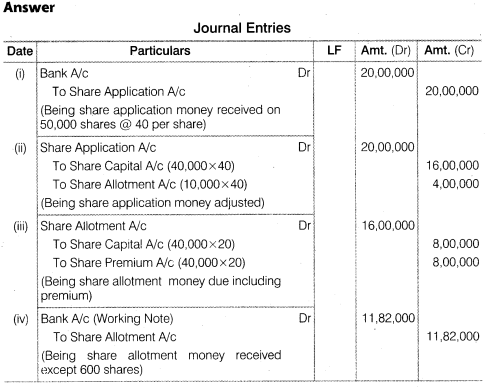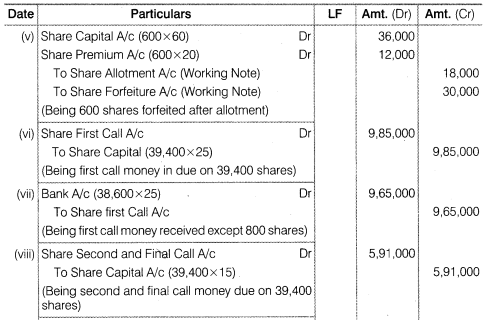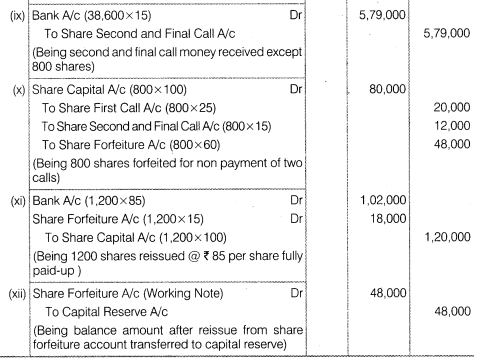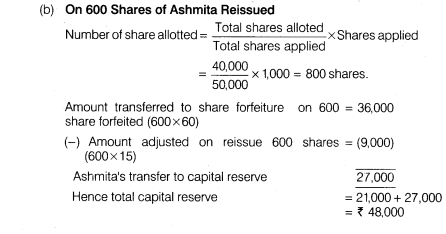NCERT Solutions for Class 12 Accountancy Part II Chapter 1 Accounting for Share Capital
Test Your Understanding I
• State which of the following statements are true
(a) A company is formed according to the provisions of Indian Companies Act, 1932.
Answer False
(b) A company is an artificial person.
Answer True
(c)Shareholders of a company are liable for the acts of the company.
Answer False
(d) Every member of a company is entitled to take part in its management.
Answer False
(e) Company’s shares are generally transferable.
Answer True
(f) Share application account is a personal account.
Answer True
(g) The director of a company must be a shareholder.
Answer True
(h) Application money should not be less than 25% of the face value of shares.
Answer False
(i) Paid-up capital can exceed called-up capital. .
Answer True
(j) Capital reserves are created from capital profits.
Answer True
(k) Securities premium account is shown on the assets side of the balance sheet.
Answer False
(l) Premium on issue of shares is a capital loss.
Answer False
(m) At the time of issue of shares, the maximum rate of securities premium is 10%.
Answer False
(n) The part of capital which is called-up only on winding up is called reserve capital.
Answer True
(o) Forfeited shares can not be issued at a discount.
Answer False
(p) The shares originally issued at discount may be re-issued at a premium.
Answer True
Do it Yourself I
Question 1. On January 01, 2006, a limited company was incorporated with an authorised capital of Rs.40,000 divided into shares of Rs.10 each. It offered to the public for subscription of 3,000 shares payable as follows
Rs.
On Application 3 per share
On Allotment 2 per share
On First Call (One month after allotment) 2.50 per share
On Second and Final Call 2.50 per share
The shares were fully subscribed for by the public and application money duly received on January 15, 2006. The directors made the allotment on February 1, 2006.
How will you record the share capital transactions in the books of a company if the amounts due has been duly received, and the company maintains the combined account for application and allotment.
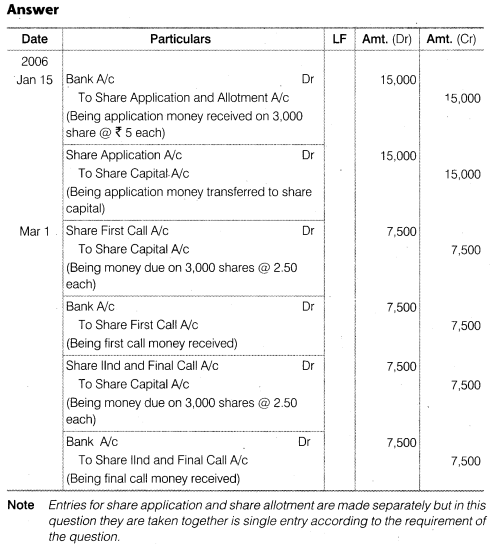
Do it Yourself II
1. A company issued 20,000 equity shares of Rs.10 each payable at Rs.3 on
application, Rs.3 on allotment, Rs.2 on first call and Rs.2 on second and the
final call. The allotment money was payable on or before May 01, 2005; first
call money on or before August Ist, 2005; and the second and final call on or
before October Ist, 2005; ‘X’, whom 1,000 shares were allotted, did not pay the
allotment and call money; ‘Y’, an allottee of Rs.600 shares, did not pay the
two calls; and ‘Z’, whom 400 shares were allotted, did not pay the final call.
Pass journal entries and prepare the Balance Sheet of the company as on
December 31, 2005.
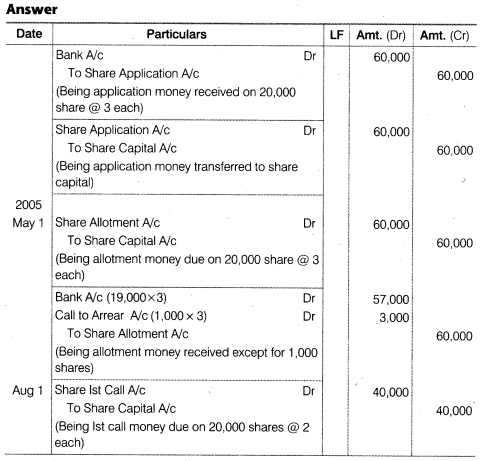
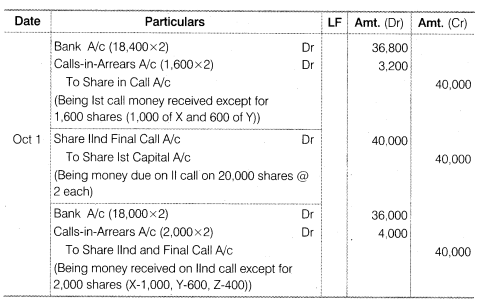
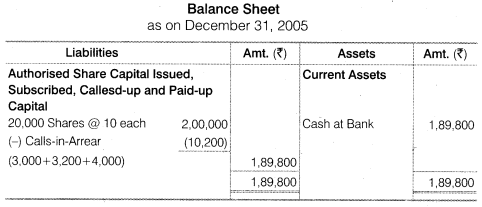
2. Alfa company Ltd. issued 10,000 shares of Rs.10 each for cash payable at Rs.3
on application, Rs.2 on allotment and the balance in two equal instalments.
The allotment money was payable on or before March 3, 2006; the first call
money on or before 30 June, 2006; and the final call money on or before 31st
August, 2006. Mr. ‘A’, whom 600 shares were allotted, paid the entire remaining
face value of shares allotted to him on allotment. Record journal entries in
company’s books and also prepare their balance sheet on the date.
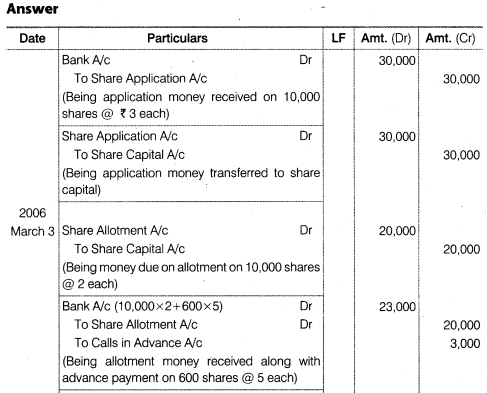
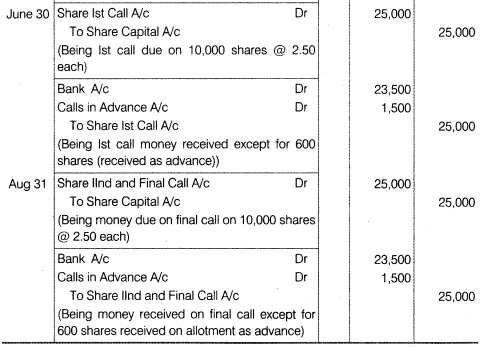
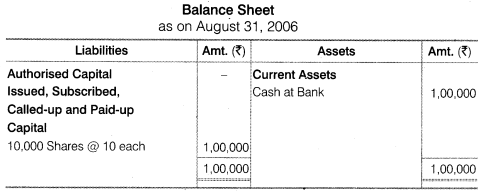
Test your Understanding – II
Choose the Correct Answer.
(a) Equity share holders are :
(i) creditors
(ii) owners
(iii) customers of the company.
Answer (ii) Owners
(b) Nominal share capital is :
(i) that Part of the authorised capital which is issued by the company.
(ii) the amount of capital which is actually applied for by the prospective shareholders.
(iii) the maximum amount of share capital which a company is authorised to issue.
Answer (iv) the amount actually paid by the shareholders.
(c) Interest on calls-in-arrears is charged according to “Table A” at :
(i) 5%
(ii) 6%
(iii) 8%
(iv) 11%
Answer (i) 5%
(d) Money received in advance from shareholders before it is actually called-up by the directors is :
(i) debited to calls-in-advance account
(ii) credited to calls-in-advance account
(iii) debited to calls account.
Answer (ii) Credited to calls account
(e) Shares can be forfeited
(i) for non-paymnt of call money
(ii) for failure to attend meetings
(iii) for failure to repay the loan to the bank
(iv) for which shares are pledged as a security.
Answer (i) For non-paymntof call money
(f) The balance of share forfeited account after the reissue of forfeited shares is transferred to
(i) general reserve
(ii) capital redemption reserve
(iii) capital reserve
(iv) reveneue reserve
Answer (iii) Capital
(g) Balance of share forfeiture account is shown in the balance sheet under the item :
(i) current liabilities and provisions
(ii) reserves and surpluses
(iii) share capital account
(iv) unsecured loans
Answer (iii) Share capital account
Do it Yourself III
1. A company forfeited 100 equity shares of Rs.10 each issued at a premium of
20% for non-payment of final call of Rs.5 including the premium. Show the
journal entry to be passed for forefeiture of shares.

2. A company forfeited 800 equity shares of Rs.10 each issued at a discount of 10% for non-payment of two calls of Rs.2 each. Calculate the amount forfeited by the company and pass the journal entry for forefeiture of the shares.
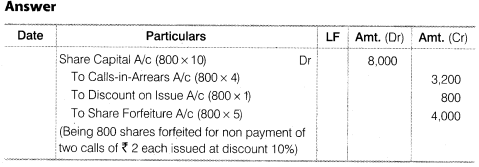
Do it Yourself IV
Excell Company Limited made an issue of 1,00,000 Equity Shares of Rs.10 each,
payable as follows :
Rs.
On Application Rs.2.50 per share
On Allotment Rs.2.50 per share
On Ist and Final Call Rs.5.00 per share
X, the holder of 400 shares did not pay the call money and his shares were forfeited. Two hundred of the forfeited shares were reissued as fully paid at Rs.8 per share. Draft necessary journal entries and prepare Share Capital and Share Forfeited’ accounts in the books of the company.
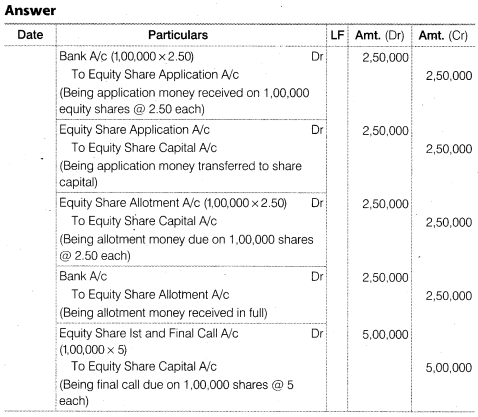
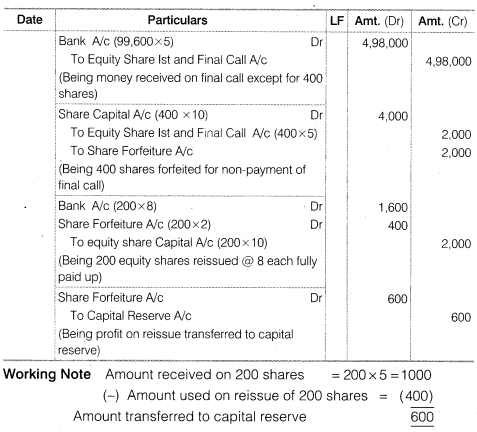
Test your Understanding – III
(a) If a Share of Rs. 10 on which Rs. 8 is called-up and Rs. 6 is paid is forfeited. State with what amount the Share Capital account will be debited.
(b) If a Share of Rs. 10 on which Rs. 6 has been paid is forfeited, at what minimum price it can be reissued.
(c) Allhuwalia Ltd. issued 1,000 equity shares of Rs. 100 each as fully paid-up in consideration of the purchase of plant and machinery worth Rs. 1,00,000. What entry will be recorded in company’s journal.
Answer
(a) On forfeiture, share capital is debited with called up amount i.e.,X 8.
(b) The total price of money collected from 1st issue and reissue should be equal to face value atleast. It can exceed also. The share can be reissue for minimum ? 4 per share.
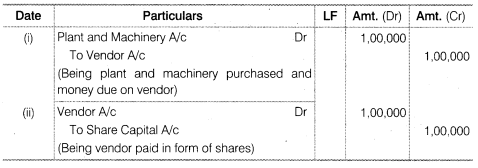
Do it Yourself V
Journalise the following :
(a) The directors of a company forfeited 200 equity shares of Rs. 10 each on which Rs. 800 had been paid. The Shares were re-issued upon payment of Rs. 1,500.
(b) A holds 100 shares of Rs. 10 each on which he has paid Re. 1 per share on application. B holds 200 Shares of Rs. 10 each on which he has paid Re. 1 on application Rs. 2 on allotment. C holds 300 shares of Rs. 10 each who has paidRe. 1 on applications, Rs. 2 on allotment and Rs. 3 on first call. They all failed to pay their arrears and second call of Rs. 4 per share as well. All the shares of A, B and C were forfeited and subsequently reissued at Rs. 11 per share as fully Paid-up.
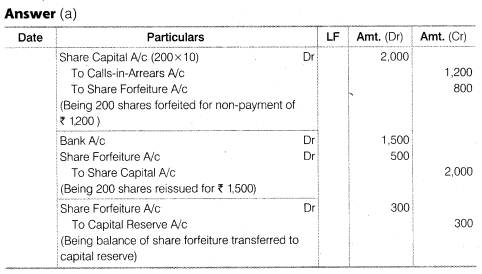
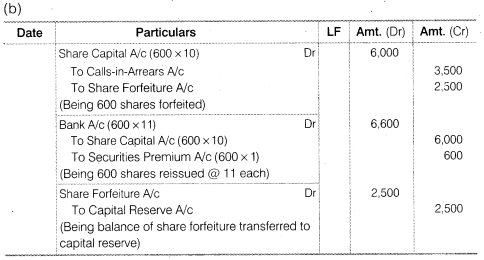


Short Answer Type Questions
Question 1. What is public company?
Answer Minimum requirement of a public company is seven person. As per the Section 3 (1) (iv) of Companies Act 1956, public company is a company which (a) is not a private company, (b) has minimum capital of ?5 lakh or such higher paid-up capital as may be prescribed, and (c) is a private company which is a subsidiary public company.
Question 2. What is private limited company?
Answer As per Section 3 (1) (iii) of Companies Act 1956, A private company is one which has a minimum paid up capital of ^ 1 lakh or such higher paid-up capital as may be prescribed by its Articles
(i) Restricts the right to transfer its shares.
(ii) Limits the number of its members to fifty (excluding its employees).
(iii) Prohibits any invitation to the public to subscribe for any shares in or debentures of the company.
(iv) Prohibits any invitation or acceptance of deposits from person other than its members, directors and relatives.
Question 3. Define Government Company.
Answer Section 617 of Companies Act 1956 defines Government Company as a company in which not less than 51% of the paid up share capital is held by the Central Government or by any State Government or Governments or partly by the Central Government and partly by one or more State Governments and includes a company which is a subsidiary of a Government Company.
Question 4. What do you mean by a listed company?
Answer Listed companies are those companies whose shares are listed on a recognised stock exchange for public trading. When a company’s security is listed in a recognised stock exchange the price fluctuation can easily be observed by the investor and he/she can easily determine the increase/decrease in value of their investment in a concerned listed company.
This is the only reason that the volume remain high in case of a listed company as all the moves can be observed and investment strategy can easily be planned in that company.
Question 5. What are the uses of securities premium?
Answer When securities like shares and debentures are issued to public more than their face value the excess is called security premium. As per the Section 78 of the Companies Act 1956, the amount of securities premium can be used by the company for the following purposes
(i) For paying up unissued shares of the company to be issued to members (shareholders) of the company as fully paid bonus share.
(ii) For writing off the preliminary expenses of the company.
(iii) For writing off the expenses of, or the commission paid or discount allowed on, any issue of shares or debentures of the company.
(iv) For paying up the premium that is to be payable on redemption of preference shares or debentures of the company.
(v) Further, as per the Section 77A, the securities premium amount can also be utilised by the company to buy-back its own shares.
Question 6. What is buy-back of shares?
Answer When a company repurchase its own share from the market to reduce the number of share it is called buy-back of shares. As per the Section 77A of the Companies Act, 1956 the procedure for buy back of share would be as follows
(i) First of all the Articles of the Association must authorise the company for the buy-back of shares.
(ii) A special resolution must be passed in the companies’ Annual general body meeting.
(iii) The amount of buy-back of shares should not exceed 25% of the paid-up capital and free reserves.
(iv) The debt-equity ratio should not be more than a ratio of 2:1 after the buyback.
(v) All the shares of buy-back should be fully paid-up.
(vi) The buy-back of the shares should be completed within 12 months from the date of passing the special the resolution.
(vii) The company should file a solvency declaration with the Registrar and’ SEBI which must be signed by at least two directors of the company. –
Sources for Buy-back of Share
(i) Free reserves.
(ii) Securities premium account.
(iii) Proceeds of any shares or other specified securities, provided that no buy-back of any kind of shares or other specified securities shall be made out of the proceeds of the earlier issues of the similar kind of shares or specified securities.
Question 7. Write a brief note on ‘Minimum Subscription’
Answer When shares are issued to the general public, it is necessary that the minimum subscription amount should be subscribed so that the company can allot shares to the applicants. This minimum amount of share subscription is termed as minimum subscription. As per the Company Act 1956, the minimum subscription of share cannot be less than 90% of the issued amount. If the minimum subscription is not received, the company cannot allot shares to its applicants and it shall immediately refund the entire application amount received to the public.
e.g., if a company issued 1,00,000 equity share than at least 90,000 share must be subscribed by the public.
Long Answer Type Questions
Question 1. What is meant by the word ‘Company’? Describe i characteristics.
Answer According to Section 3 (1) (i) of the Company Act of 195 “Company means a company formed and registered under this Act or £ existing company.”
In general, a company is an artificial person, created by law that has separate legal entity, perpetual succession, and common seal and t limited liability. It is a voluntary association of person who together contribu in the capital of the company to do business.
Generally, the capital of a company is divided into small parts known shares, the ownership of which is transferable subject to certain terms s conditions.
Characteristics of Company
(i) Incorporated Association A company comes into existence through the operation of law. Therefore, its incorporation under the Companies Act is must. Without such registration, no company can come into existence. Being created by law, it is regarded as an artificial legal person.
(ii) Separate Legal Entity A company has a separate legal entity, which is not affected by changes in the membership. Therefore being a separate entity, a company can contract, sue and be used in its corporate name and capacity.
(iii) Artificial Person A company is an artificial and juristic person that is created by law.
(iv) Limited Liability Every shareholder of accompany has limited liability. His liability is limited to the extent of the unpaid value of the shares held by him. If such shares are fully paid up, he is subject to no further liability.
(v) Perpetual Existence The existence of company is not affected by the death, retirement, and insolvency of its members. That is, the life of a company remains unaffected by the life and the tenure of its members in the company. The life of a company is infinite until it is properly wound up as per the Companies Act.
(vi) Common Seal The company is not a natural person and has no physical existence. Hence, it cannot put its signature. Thus, the common seal acts as an official signature of a company that validates the official documents.
(vii) Maintenance of Books A limited company is required by law to keep a prescribed set of account books and any failure in this regard attracts penalties.
Question 2. Explain in brief the main categories in which the share capital of a company is divided.
Answer Share capital of a company can be divided into the following categories
(i) Authorised Capital It refers to that amount which is laid down in clause of the memorandum of association of the company. This i maximum amount with which company is registered and to raise from the public by the issue of shares. The therefore, called the registered or nominal or authorised capital of company.
(ii) Issued Capital The authorised capital which is offered to the public for subscription including shares offered to the vendors for subscription other than cash is called the issued capital.
(iii) Subscribed Capital It is the portion of issued capital which has been subscribed to by the public i.e., applied for and allotted by the company. Thus, face value of allotted shares is known as subscribed capital.
(iv) Called-up Capital The portion of the subscribed capital which the shareholders are called upon to pay is termed as called up capital of the company. The company usually does not require a shareholder to pay in one lot, the full value of the shares he has subscribed for. He is generally required to pay it by instalments. The balance of subscribed capital which has not been called-up represents uncalled capital.
(v) Paid-up Capital The amount of called-up capital which has been actually paid by the shareholders is called as paid-up capital and the amounts yet due from the shareholders are called as calls-in-arrears.
(vi) Reserve Capital Sometimes a company by means of special resolution decides that certain portion of its uncalled capital shall not be called-up during its existence and it would be available as an additional security to its creditors in the event of its liquidation. Such a portion of uncalled capital is termed as reserve capital.
Question 3. What do you mean by the term ‘share? Discuss the type of shares, which can be issued under the Companies Act, 1956 as amended to date.
Answer The capital of a company is divided into a number of equal parts. Each part is called a share. A company may divide its capital into shares of ? 10, ? 50, ^100 or any suitable amount, but it is always preferable to have shares of small denomination in order to bring them within the reach of small investor.
According to Lord Lindley, “The portion of capital to which each member is entitled to his share”. In this way, share is proportionate part of the share capital and forms ownership in a company.
According to Companies Act, 1956 there are two types of shares
(i) Preference Share Preference Share is one which carries the following two rights
(a) They have a right to receive dividend at a fixed rate before any dividend is paid on the equity shares
(b) On the winding up of the company, they have right to return of capital before the capital returned on equity shares.
However, not with standing the above two conditions, a holder of the preference share may have a right to share fully or to a limited extent in the surplus of the company as specified in the Memorandum or Articles* of the company.
(ii) Equity Share Under Indian Companies Act 1956, ‘an equity share is share which is not preference share’. Thus, this share does not carry any preferential right or in other words, equity share is one which is entitled to dividend and repayment of capital after the claim of preference shares is satisfied. Usually the equity shareholders control the affairs of the company and hence right to all the profits after the preference dividend has been paid.
Question 4. Discuss the process for the allotment of shares of a company in case of over subscription.
Answer When shares are issued to the public for subscription through the prospectus by well managed and financially strong companies, it may happen that the total number of applications received for shares exceeds the number of shares offered by the company to the public, such situation is called the situation of over-subscription. A company can opt for any of the three alternatives to allot shares in case of over-subscription of shares.
(i) Excess Applications are Refused and Money received on Excess Applications is Returned to the Applicants

(ii) If the Applicant are made Partially Allotment (or Pro-rata Basis) In case of over-subscription, when a company allots shares rateable to all the applicants, it is called as pro-rata allotment.
In such a case, the main problem is what to do with the excess amount received on application. Practically, it will be quite irrational to refund the excess money first and then ask the allottee applicants to pay the allotment money.
In practice, generally excess application money receive on these shares is adjusted towards the amount due on allotment or call. For this purpose the entry is made as follows
Pro-rata and Refund of Money In case of over-subscription, the director can adopt a combination of the above two alternatives i.e., they can accept full allotment to some applications, a pro-rata allotment to others and no allotment to the rest.

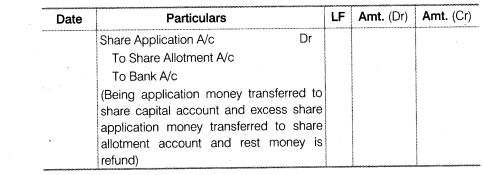
Question 5. What is a ‘Preference Share’? Describe the different types of preference shares.
Answer Preference share is one which carries the following two rights
(i) They have a right to receive dividend at a fixed rate before any dividend is paid on the equity shares.
(iii) On the winding up of the company, they have right to return of capital before of the capital returned on equity shares.
However, not with standing the above two conditions, a holder of the preference share may have a right to share fully or to a limited extent in the surplus of the company as specified in the Memorandum or Articles of the Company.
Preference shares can be of various types which are as follows
(i) Cumulative Preference Shares If there are no profits in one year and the arrears of dividends are to be carried forward and paid out of the profits of subsequent years, the preference share is said to be cumulative. It is noted that the company should pay dividend out of profits only.
(ii) Non-Cumulative Preference Shares If unpaid dividend lapses, the share is said to be non-cumulative preference share. It means when a preference shareholder receives dividend only in case of profit and is not entitled any right to recover the arrears of dividend, then the type of preference shares held by the shareholder is known as non-cumulative preference shares.
(iii) Redeemable Preference Shares When shares are repaid after some specified time in accordance with the terms of issue they are called redeemable preference shares.
(iv) Non-Redeemable Preference Shares These are the preference shares, which do not carry with them the arrangement regarding redemption. According to Section 80 (54), no company limited by shares shall issue irredeemable preference shares or preference shares redeemable after the expiry of 20 years from the date of issue.
(v) Participating Preference Shares When a preference shareholder enjoys the right to participate in the surplus profit (in addition to the fixed rate of dividend) that is left after the payment of dividend to the equity shareholders, the type of shares held by the shareholder is known as participating preference shares.
(vi) Non-Participating Preference Shares When a preference shareholder receives only a fixed rate of dividend every year and do not enjoy the additional participation in the surplus profit, then the type of shares held by the shareholder is known as non-participating preference shares.
(vii) Convertible Preference Shares These shares give the right to the holder to get them converted into equity shares at their option according to the terms and conditions of their issue.
(viii) Non-Convertible Preference Shares When the holder of a preference share has not been conferred the right to get his holding converted into equity share, it is called non-convertible preference shares. Preference shares are non-convertible unless otherwise stated.
Question 6. Describe the provisions of law relating to ‘Calls-in- Arrears’ and ‘Calls in Advance’
Answer Calls-in-Arrears The portion of called up capital which is not paid by the shareholder within a specified time is known as calls-in-arrears. In other words, when a shareholder fails to pay the amount due on allotment or any subsequent calls, then it is termed as call-in-arrears.
The company is authorised by its Article of Association to charge interest at a specified rate on the amount of call-in-arrears from the due date till the date of payment. If the Article of Association is silent in this regard, then Table A shall be applicable that is interest at 5% pa is charged.
It is deducted from the called-up share capital on the liabilities side of the Company’s Balance Sheet. The company can also forfeit the shares on account of non-payment of the calls money after giving proper notice to shareholders.
Calls in Advanqe It means calls not due but paid by the shareholder in advance. Thus, the amount of future calls is received in advance by the company.
In other words, when a shareholder pays the whole amount or a part of the amount in advance, i.e., before the company calls, then it is termed as calls in advance. The company is authorised by its Article of Association to pay interest at the specified rate on call in advance from the date of payment till the date of call made.
If the Article of Association is silent in this regard, then the Table A shall be applicable that is, interest at 6% pa is provided. It is shown under the heading of current liabilities on the liabilities side of the Company’s Balance Sheet.
Question 7. Explain the terms ‘Over-subscription’ and ‘Under-subscription’. How are they dealt with in accounting records?
Answer When shares are issued to the public for subscription through the prospectus by well managed and financially strong companies, it may happen that the total number of applications received for shares exceeds the number of shares offered by the company to the public, such situation is called the situation of over-subscription. A company can opt for any of the three alternatives to allot shares in case of over-subscription of shares.
(i) Excess Applications are Refused and Money Received on Excess Applications is Returned to the Applicants

(ii) If the Applicant are made Partially Allotment (or Pro-rata Basis) In case of over-subscription, when a company allots shares rateable to all the applicants, it is called as pro-rata allotment. In such a case the main problem is what to do with the excess amount received on application.
Practically, it will be quite irrational to refund the excess money first and then ask the allottee applicants to pay the allotment money.
In practice, generally excess application money receive on these shares is adjusted towards the amount due on allotment or call. For this purpose the entry is made as follows

(iii) Pro-rata and Refund of Money In case of over-subscription, the director can adopt a combination of the above two alternatives i.e., they ,can accept full allotment to some applications, a pro-rata allotment to others and no allotment to the rest.
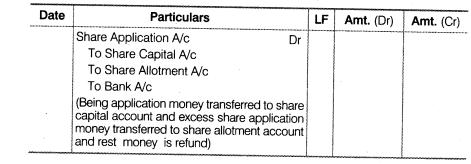
Under-Subscription: In case when share are issued by the company and the number of shares applied by the public is lesser than the number of shares issued this is called the situation of under-subscription.
As per the Comprise Act, the minimum subscription is 90% of the shares issued by the company. This implies that the company can allot shares to the applicants provided if applications for 90% of the issued shares are received. Otherwise, the company should refund the entire application amount received.
In this regard, necessary journal entry is passed only after receiving and refunding of the application. In this case, normal entries are made as the adjustment is not needed for any excess.
Question 8. Describe the purposes for which a company can use ‘Securities Premium Account.
Answer Securities premium account can be used only for the following four purposes as laid down by Section 78 of the Companies Act 1956
(i) To issue fully paid bonus shares to an extent not exceeding unissued share capital of the company.
(ii) To write-off preliminary expenses of the company.
(iii) To write-off the expenses of, or commission paid, or discount allowed on any of the shares or debentures of the company.
(iv) To pay premium on the redemption of preference shares or debentures of the company.
Question 9. State clearly the conditions under which a company can issue shares at a discount.
Answer In normal condition as a general rule, a company cannot ordinarily issue shares at a discount. It can do so only in cases such as ‘reissue of forfeited shares’ and in accordance with the provisions of Section 79 of the Companies Act. According to Section 79 of the Companies Act, 1932, a company is permitted to issue shares, at a discount provided the following conditions ara satisfied
(i) The issue of shares at a discount is authorised by an ordinary resolution passed by the company at its general meeting and sanctioned by the Company Law Board now Central Government.
(ii) The resolution must specify the maximum rate of discount at which the shares are to be issued but the rate of discount must not exceed 10 per cent of the nominal value of shares. The rate of discount can be more than 10 per cent if the government is convinced that a higher rate is called-for under special circumstances of a case.
(iii) At least one year must have elapsed since the date on which the company became entitled to commence the business.
(iv) The shares are of a class which has already been issued. •
(v) The shares issued within two months from the date of receiving sanction for the same from the government or within such extended period as the government may allow.
(vi) If the offer prospectus at the date of issue must mention particulars of the discount allowed on the issue of shares.
Question 10. Explain the term ‘Forfeiture of Shares’ and give the accounting treatment on forfeiture.
Answer If a shareholder fails to pay the allotment money and or any call money on his shares as called upon by the directors, his shares may be forfeited by the directors, if they are so authorised by the Articles of Association. This is known as forfeiture of shares.
As per the Table A of the Company Act, the procedure of forfeiting shares is mentioned below.
(i) A notice is sent to default shareholder stating him/her to pay calls-in-arrears along with the interest accrued on the outstanding calls money within a period of 14 days of the receipt of notice, otherwise, the shares will be forfeited.
(ii) If the shareholder does not pay the amount, then the company has the right to forfeit his/her share by passing a resolution.
(iii) A notice of that resolution is send to the default shareholder and a public notice of the same is published in a daily newspaper.
(iv) The name of the shareholder is removed from the register of members (i.e., shareholders).
Accounting Treatment for Forfeiture of Shares
(i) Forfeiture of Shares that were Issued at Par
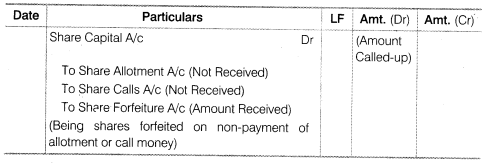
(ii) Forfeiture of Shares that were Issued at Premium
(a) Sometimes forfeited shares would have been issued at premium in that case if amount of premium is received than premium received is not shown.
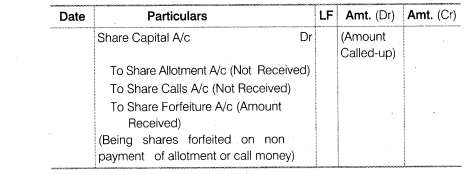
(b) Sometimes forfeited shares would have been issued at premium in that case if amount of premium is not received than premium not received is shown.
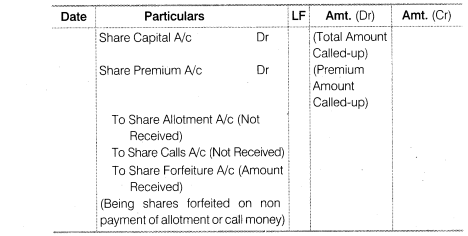
(iii) Forfeiture of shares that were issued at discount Sometimes forfeited shares would have been issued at discount in that case amount of discount will always be shown.
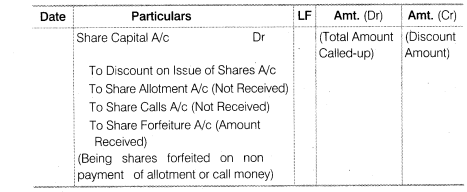
NUMERICAL QUESTIONS
1. Anish Limited issued 30,000 equity shares of Rs.100 each payable at Rs.30 on application, Rs.50 on allotment and Rs.20 on Ist and final call. All money was duly received. Record these transactions in the journal of the company.
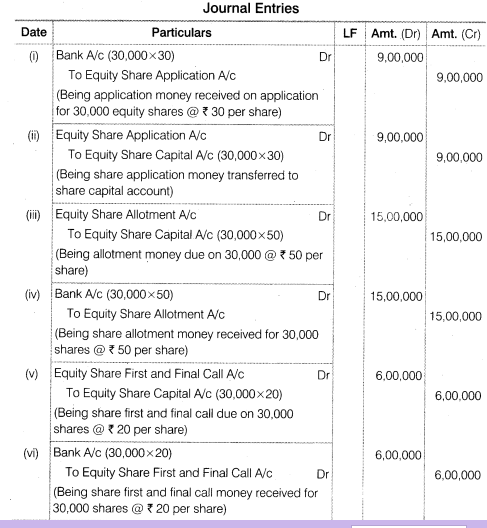
2. The Adersh Control Device Ltd was registered with the authorised capital of Rs.3,00,000 divided into 30,000 shares of Rs.10 each, which were offered to the public. Amount payable as Rs.3 per share on application, Rs.4 per share on allotment and Rs.3 per share on first and final call. These share were fully subscribed and all money was dully received. Prepare journal and Cash Book.
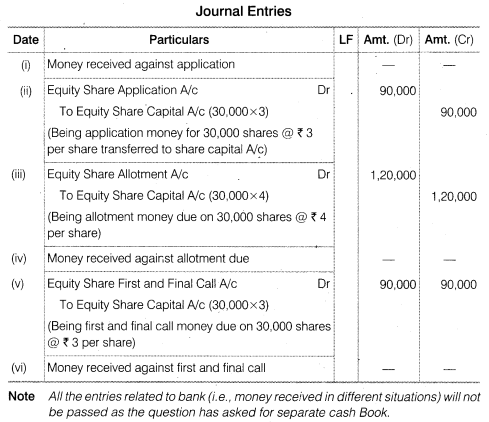
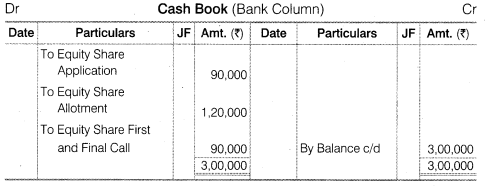
3. Software solution India Ltd inviting application for 20,000 equity share of Rs.100 each, payable Rs.40 on application, Rs.30 on allotment and Rs.30 on call. The company received applications for 32,000 shares.
Application for 2,000 shares were rejected and money returned to Applicants. Applications for 10,000 shares were accepted in full and applicants for 20,000 share allotted half of the number of share applied and excess application money adjusted into allotment. All money received due on allotment and call. Prepare journal and cash book.
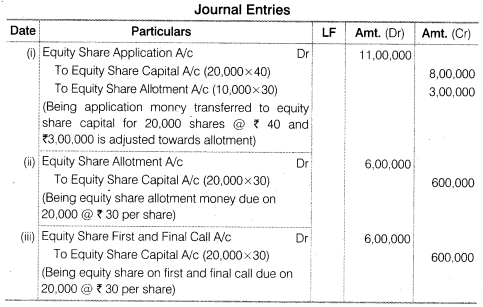
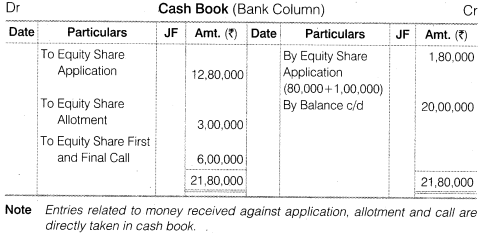
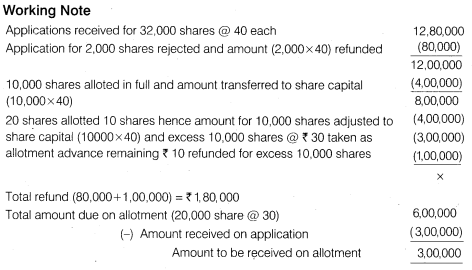
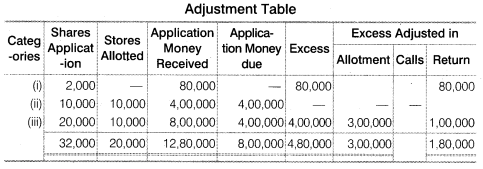
4. Rupak Ltd. issued 10,000 shares of Rs.100 each payable Rs.20 per share on application, Rs.30 per share on allotment and balance in two calls of Rs.25 per share. The application and allotment money were duly received. On first call
all member pays their dues except one member holding 200 shares, while another member holding 500 shares paid for the balance due in full. Final call was not made. Give journal entries and prepare cash book.
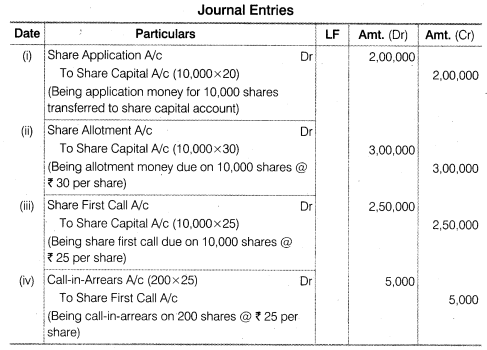
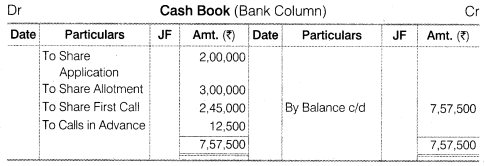
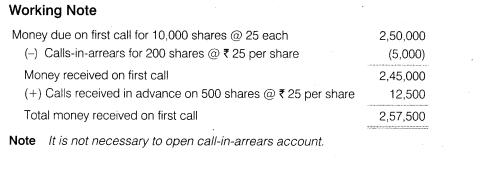
5. Mohit Glass Ltd. issued 20,000 shares of Rs.100 each at Rs.110 per share, payable Rs.30 on application, Rs.40 on allotment (including Premium), Rs.20 on first call and Rs.20 on final call. The applications were received for 24,000
shares and allotted 20,000 shares and reject 4,000 shares and amount returned thereon. The money was duly received. Give journal entries.
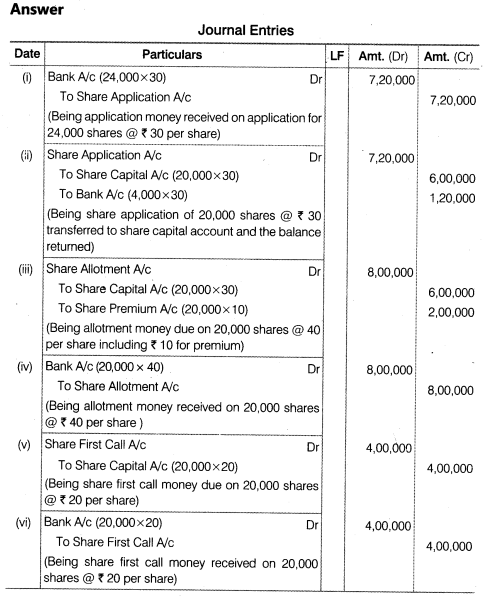
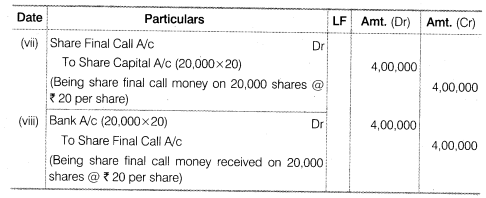
6. A limited company offered for subscription of 1,00,000 equity shares of Rs.10 each at a premium of Rs.2 per share. 2,00,000. 10% Preference shares of Rs.10 each at par.
The amount on share was payable as under :
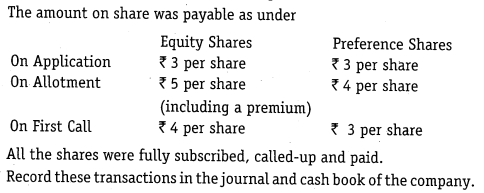
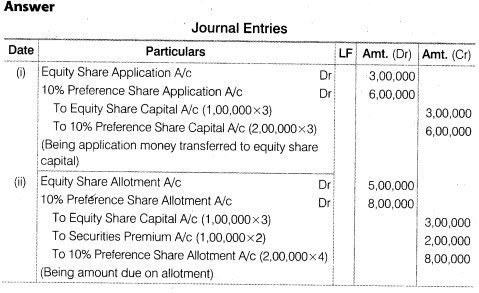

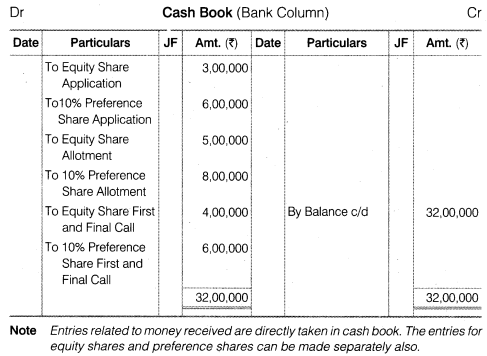
7. Eastern Company Limited, having an authorised capital of Rs.10,00,000 in shares of Rs.10 each, issued 50,000 shares at a premium of Rs.3 per share payable as follows :

Applications were received for 60,000 shares and the directors allotted the shares as follows :
(a) Applicants for 40,000 shares received shares, in full.
(b) Applicants for 15,000 shares received an allotment of 8,000 shares.
(c) Applicants for 500 shares received 200 shares on allotment, excess money being returned.
All amounts due on allotment were received. The first call was duly made and the money was received with the exception of the call due on 100 shares.
Give journal and cash book entries to record these transactions of the company. Also prepare the Balance Sheet of the company.
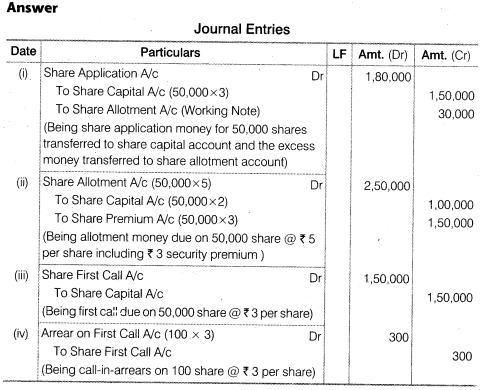
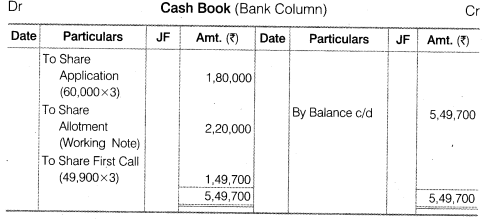
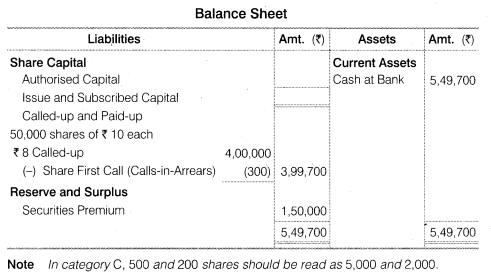
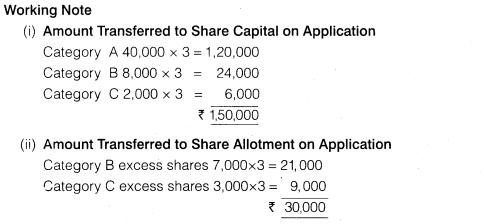
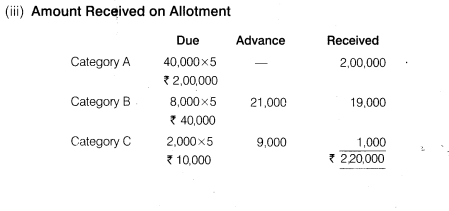
8. Sumit Machine Ltd issued 50,000 shares of Rs.100 each at discount of 5%. The shares were payable Rs.25 on application, Rs. 40 on allotment and Rs.30 on first and final call. The issue were fully subscribed and money were duly
received except the final call on 400 shares. The discount was adjusted on allotment. Give journal entries and prepare balance sheet.
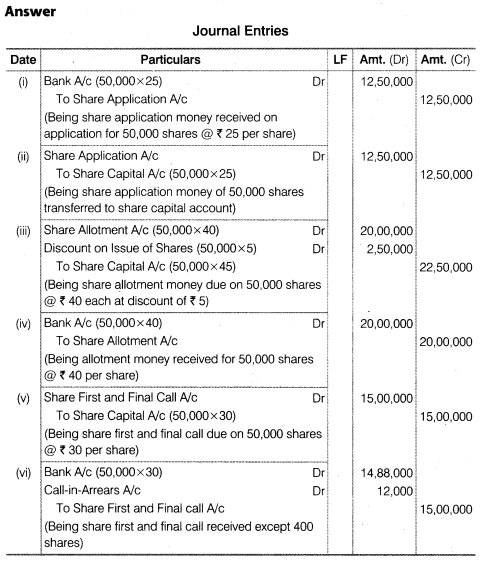
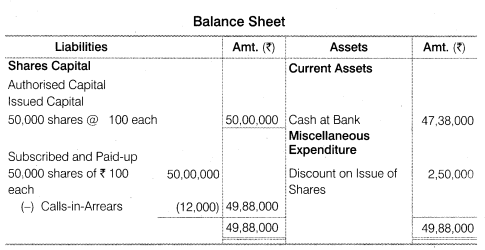
9. Kumar Ltd purchases assets of Rs.6,30,000 from Bhanu Oil Ltd. Kumar Ltd. issued equity share of Rs.100 each fully paid in consideration. What journal entries will be made, if the share are issued, (a) at par, (b) at discount of 10 %
and (c) at premium of 20%
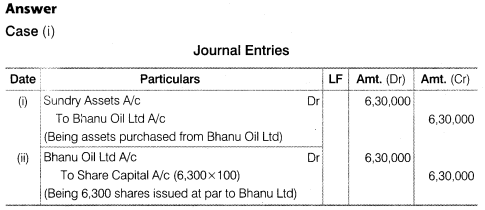
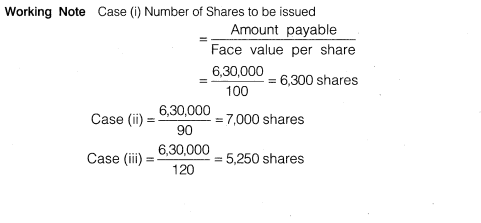
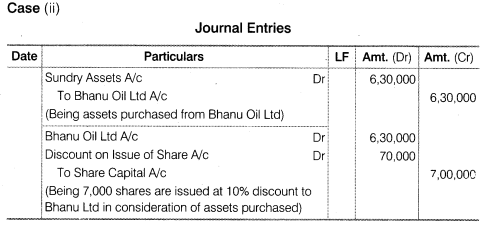
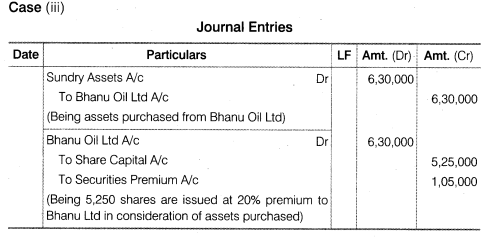
10. Bansal Heavy machine Ltd purchased machine worth Rs.3,20,000 from Handa Trader. Payment was made as Rs.50,000 cash and remaining amount by issue of equity share of the face value of Rs. 100 each fully paid at an issue
price of Rs.90 each. Give journal entries to record the above transaction.
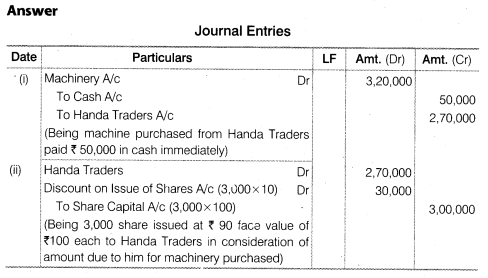

11. Naman Ltd issued 20,000 shares of Rs.100 each, payable Rs.25 on application, Rs.30 on allotment , Rs.25 on first call and The balance on final call. All money duly received except Anubha, who holding 200 shares did not pay allotment
and calls money and Kumkum, who holding 100 shares did not pay both the calls. The directors forfeited shares of Anubha and kumkum. Give journal entries.
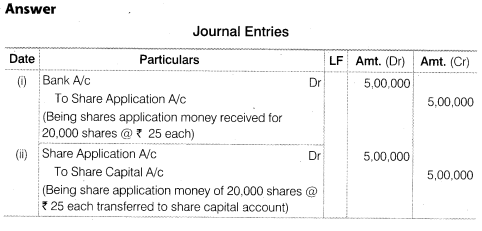
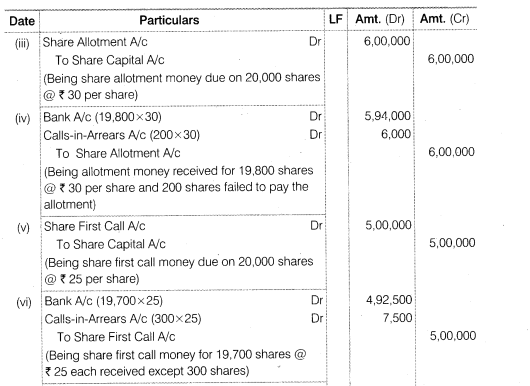
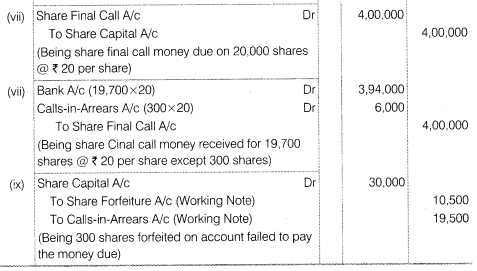


12. Kishna Ltd issued 15,000 shares of Rs.100 each at a premium of Rs.10 per share, payable as follows:

All the shares subscribed and the company received all the money due, With the exception of the allotment and call money on 150 shares. These shares were forfeited and reissued to Neha as fully paid share of Rs.12 each.
Give journal entries in the books of the company.
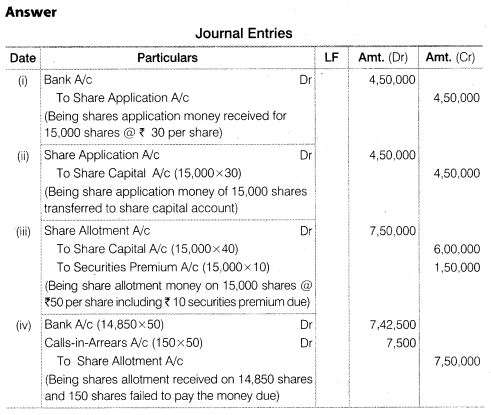
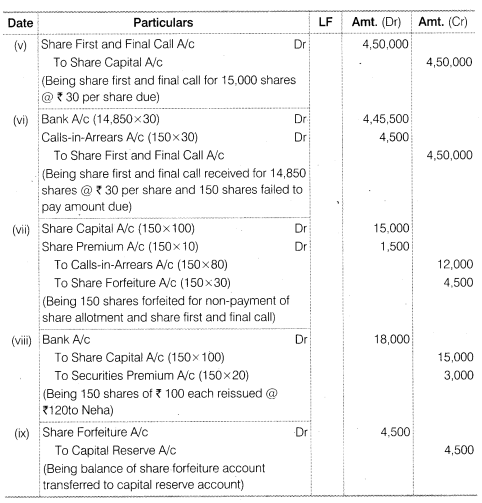
13. Arushi Computers Ltd issued 10,000 equity shares of Rs.100 each at 10% discount. The net amount payable as follows:

A shareholder holding 200 shares did not pay final call. His shares Were forfeited. Out of these 150 shares were reissued to Ms.Sonia at Rs.75 per shares. Give journal entries in the books of the company.
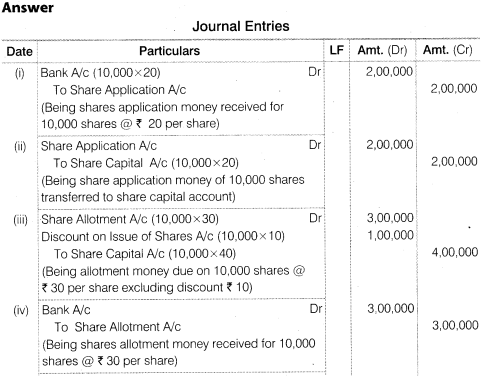
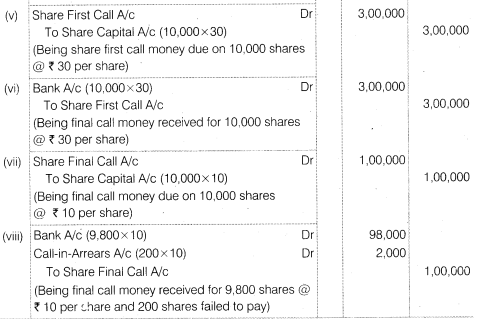
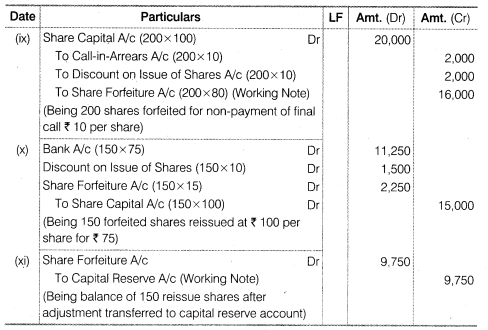
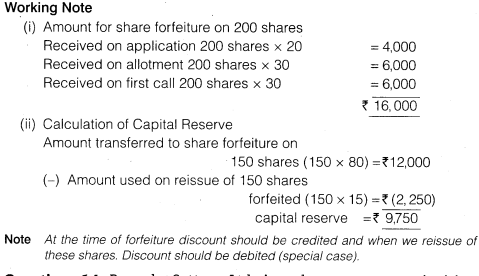
14.Raunak Cotton Ltd. issued a prospectus inviting applications for 6,000 equity shares of Rs.100 each at a premium of Rs.20 per shares, payable as follows:

Application were received for 10,000 shares and allotment was made Pro-rata to the applicants of 8,000 shares, the remaining applications Being refused. Money received in excess on the application was adjusted toward the amount
due on allotment.Rohit, to whom 300 shares were allotted failed to pay allotment and calls money, his shares were forfeited. Itika, who applied for 600 shares, failed to pay the two calls and her share were also forfeited. All these shares were sold to Kartika
as fully paid for Rs.80 per shares. Give journal entries in the books of the company
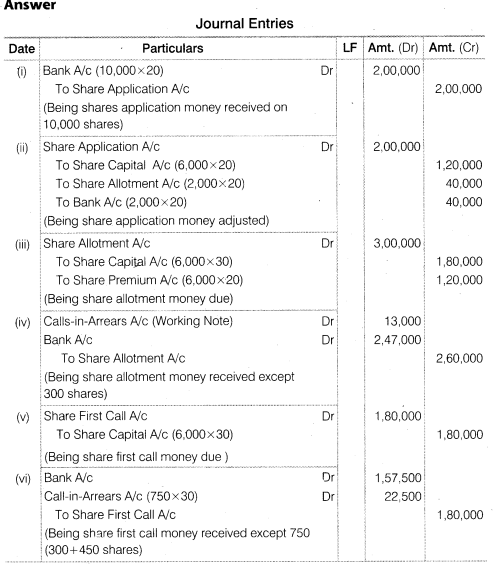
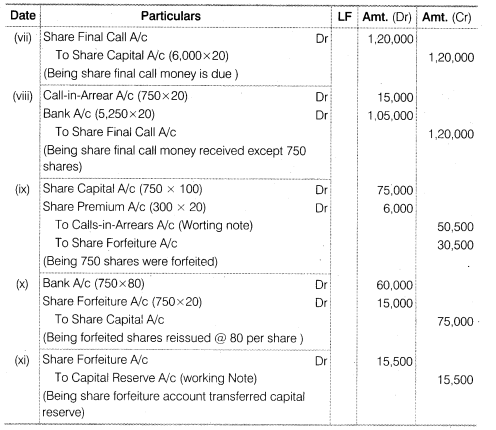
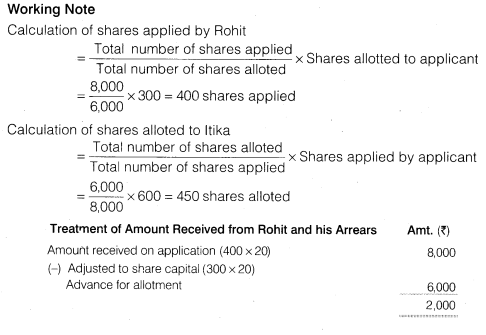
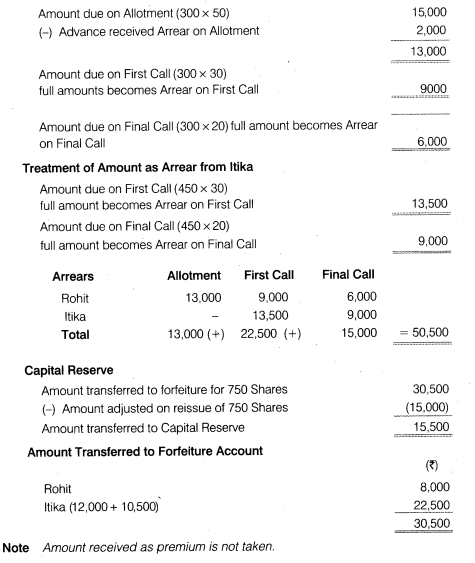
15. Himalaya Company Limited issued for public subscription of 1,20,000 equity shares of Rs.10 each at a premium of Rs.2 per share payable as under :

Applications were received for 1,60,000 shares. Allotment was made on pro-rata basis. Excess money on application was adjusted against the amount due on allotment.
Rohan, whom 4,800 shares were allotted, failed to pay for the two calls. These shares were subsequently forfeited after the second call was made. All the shares forfeited were reissued to Teena as fully paid at Rs 7 per share.
Record journal entries in the books of the company to record these transactions relating to share capital. Also show the company’s balance sheet.
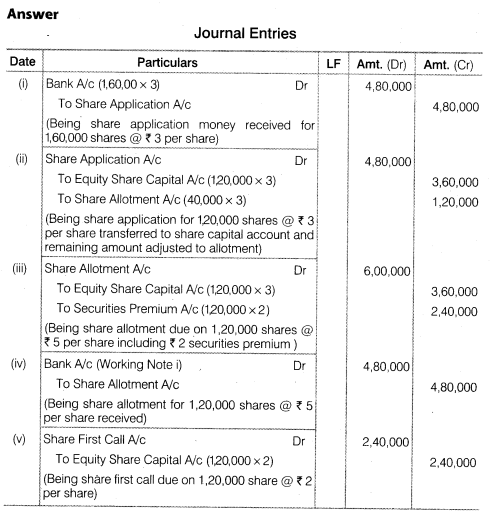
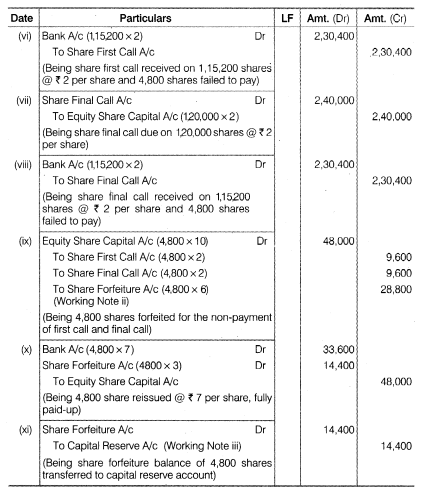
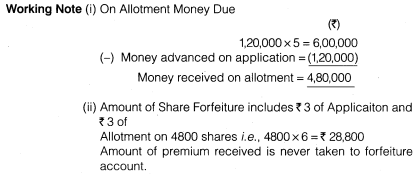

16. Prince Limited issued a prospectus inviting applications for 2,00,000 equity shares of Rs.10 each at a premium of Rs.3 per share payable as follows :

Applications were received for 30,000 shares and allotment was made on prorata basis. Money overpaid on applications was adjusted to the amount due on allotment.
Mr. ‘Mohit’ whom 400 shares were allotted, failed to pay the allotment money and the first call, and her shares were forfeited after the first call. Mr. ‘Joly’, whom 600 shares were allotted, failed to pay for the two calls and hence, his
shares were forfeited.Of the shares forfeited, 800 shares were reissued to Supriya as fully paid for Rs.9 per share, the whole of Mr. Mohit’s shares being included. Record journal entries in the books of the Company and prepare the Balance
Sheet.
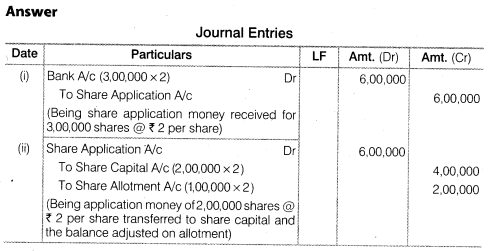
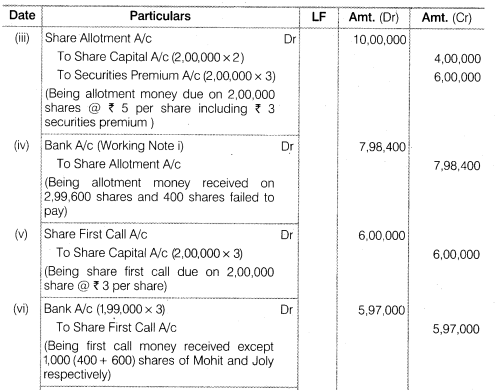
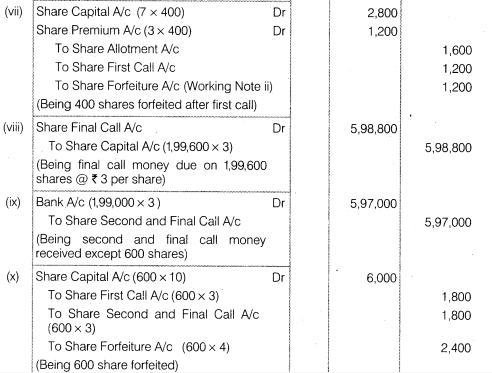
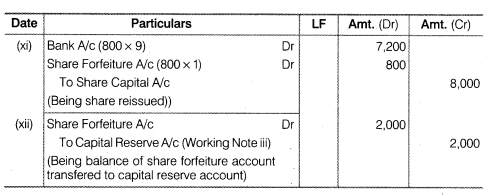
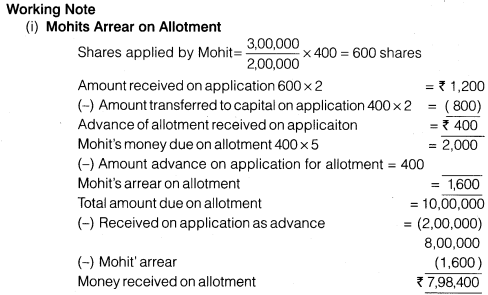
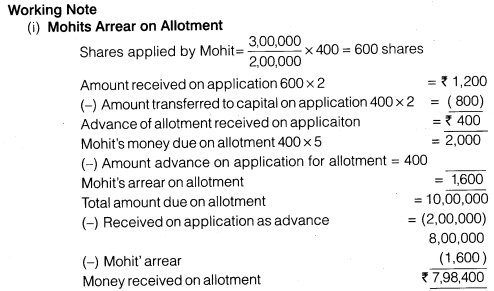
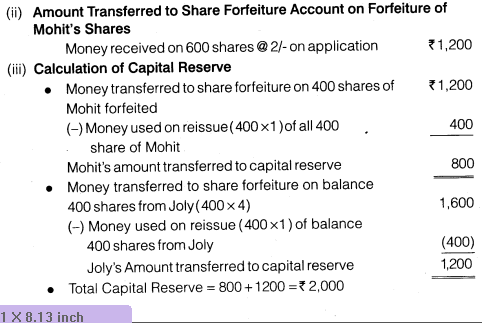
17. Life machine tools Limited, issued 50,000 equity shares of Rs.10 each at Rs.12 per share, payable at to Rs.5 on application (including premium), Rs.4 on allotment and the balance on the first and final call.
Applications for 70,000 shares had been received. Of the cash received, Rs.40,000 was returned and Rs.60,000 was applied to the amount due on allotment, the balance of which was paid. All shareholders paid the call due,
with the exception of one share holder of 500 shares. These shares were forfeited and reissued as fully paid at Rs.8 per share. Journalise the transactions.
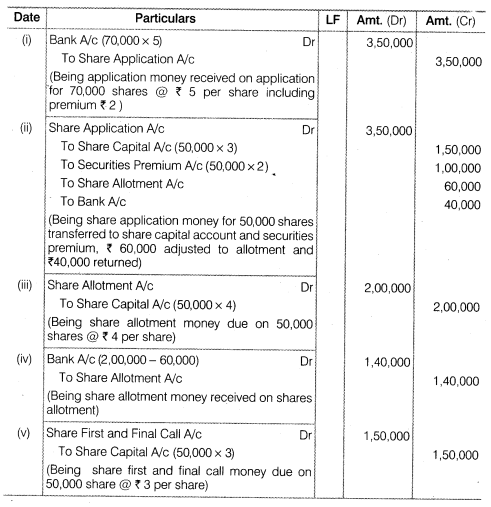
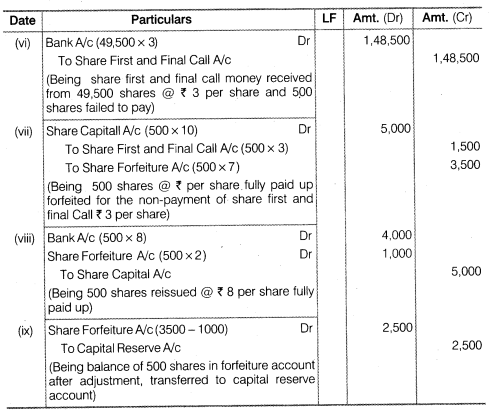
18.The Orient Company Limited offered for public subscription 20,000 equity shares of Rs.10 each at a premium of 10% payable at Rs.2 on application; Rs.4 on allotment including premium; Rs.3 on First Call and Rs.2 on Second and Final call. Applications for 26,000 shares were received. Applications for 4,000 shares were rejected. Pro-rata allotment was made to the remaining applicants. Both the calls were made and all the money were received except the final call on 500 shares which were forfeited. 300 of the forfeited shares were later on issued as fully paid at Rs.9 per share. Give journal entries and prepare the balance sheet
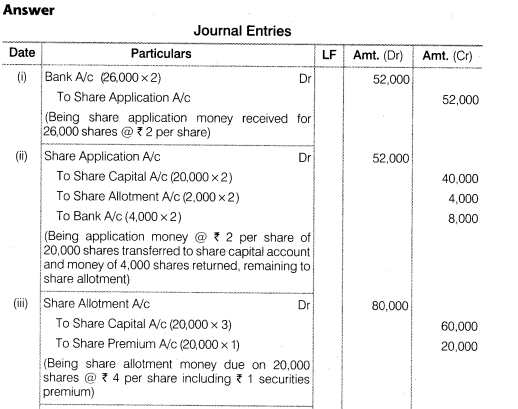
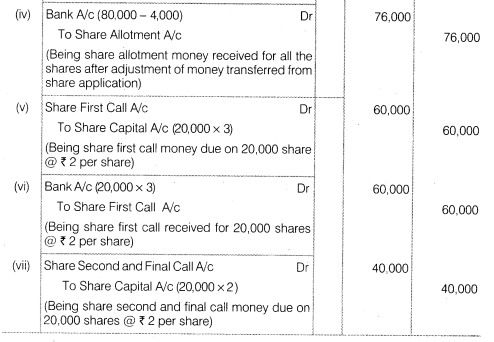
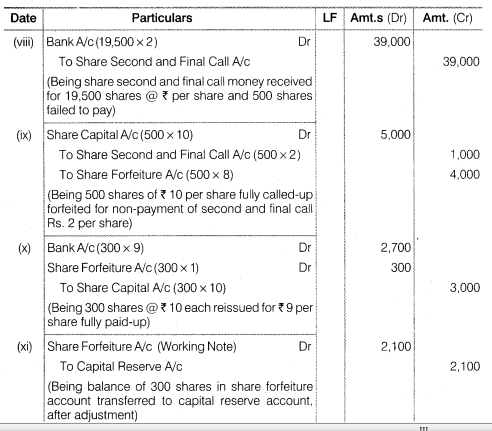

19.Alfa Limited invited applications for 4,00,000 of its equity shares of Rs.10 each on the following terms :

Applications for 5,00,000 shares were received. It was decided :
(a) to refuse allotment to the applicants for 20,000 shares;
(b) to allot in full to applicants for 80,000 shares;
(c) to allot the balance of the available shares’ pro-rata among the other applicants; and
(d) to utilise excess application money in part as payment of allotment money.
One applicant, whom shares had been allotted on pro-rata basis, did not pay the amount due on allotment and on the call, and his 400 shares were forfeited.
The shares were reissued @ Rs.9 per share. Show the journal and prepare Cash book to record the above .
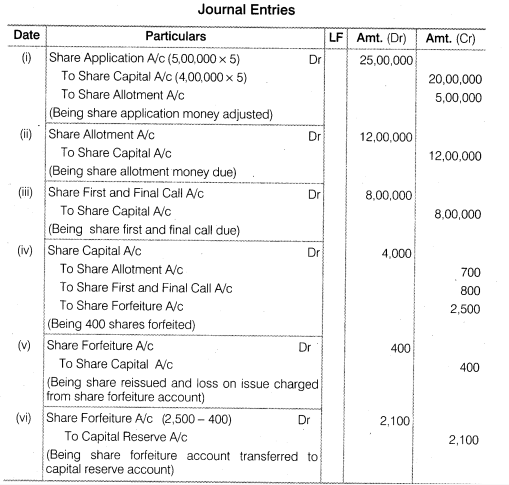
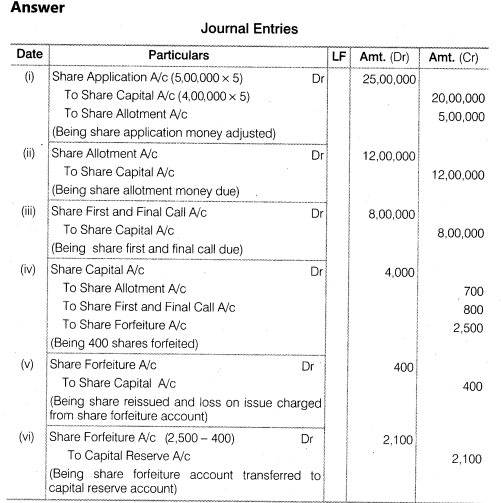
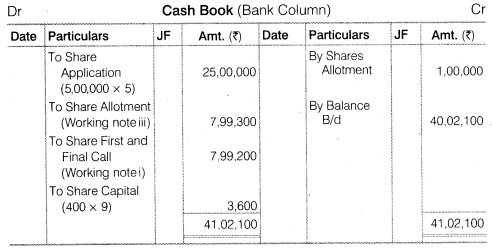

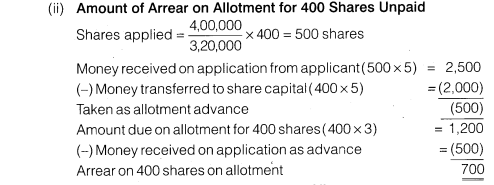


20. Ashoka Limited Company which had issued equity shares of Rs.20 each at a discount of Rs. 4 per share, forfeited 1,000 shares for non-payment of final call of Rs.4 per share. 400 of the forfeited shares are reissued at Rs.14 per share
out of the remaining shares of 200 shares reissued at Rs.20 per share. Give journal entries for the forfeiture and reissue of shares and show the amount transferred to capital reserve and the balance in Share Forfeiture Account.
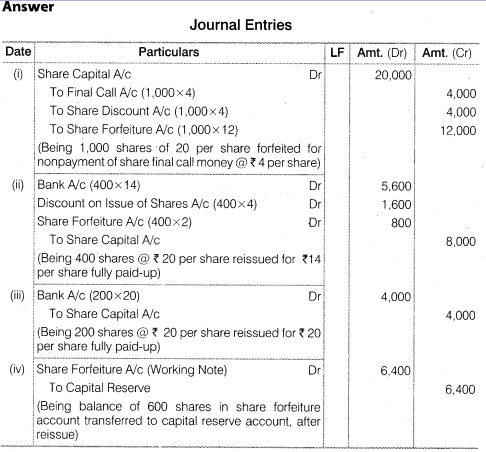
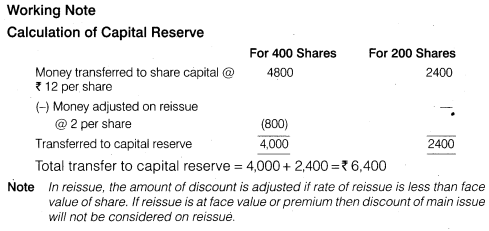
21. Amit holds 100 shares of Rs.10 each on which he has paid Re.1 per share as application money. Bimal holds 200 shares of Rs.10 each on which he has paid Re.1 and Rs.2 per share as application and allotment money, respectively.
Chetan holds 300 shares of Rs.10 each and has paid Re.1 on application, Rs.2 on allotment and Rs.3 for the first call. They all fail to pay their arrears and the second call of Rs.2 per share and the directors, therefore, forfeited their shares.
The shares are reissued subsequently for Rs.11 per share as fully paid. Journalise the transactions.
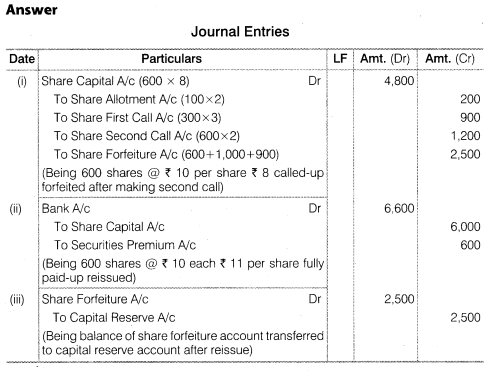
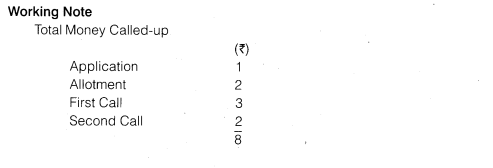


22. Ajanta Company Limited having a normal capital of Rs.3,00,000, divided into shares of Rs.10 each offered for public subscription of 20,000 shares payable at Rs.2 on application; Rs.3 on allotment and the balance in two calls of Rs.2.50
each. Applications were received by the company for 24,000 shares. Applications for 20,000 shares were accepted in full and the shares allotted. Applications for the remaining shares were rejected and the application money was refunded.
All moneys due were received with the exception of the final call on 600 shares which were forfeited after legal formalities were fulfilled. 400 shares of the forfeited shares were reissued at Rs.9 per share.Record necessary journal entries and prepare the balance Sheet showing the
amount transferred to capital reserve and the balance in Share forfeiture account.
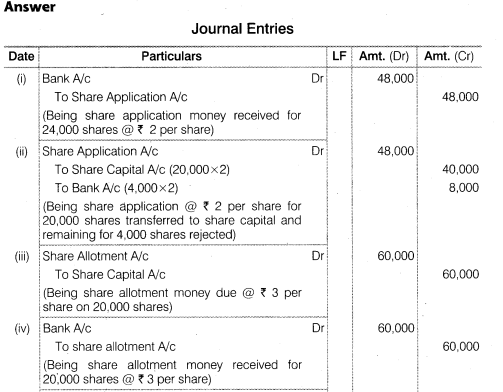
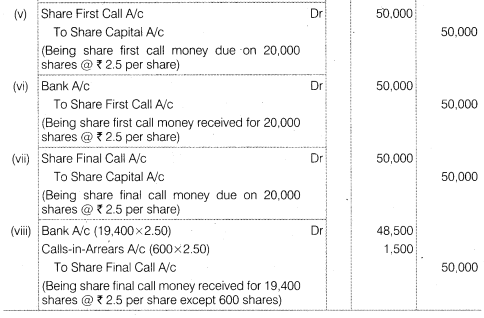
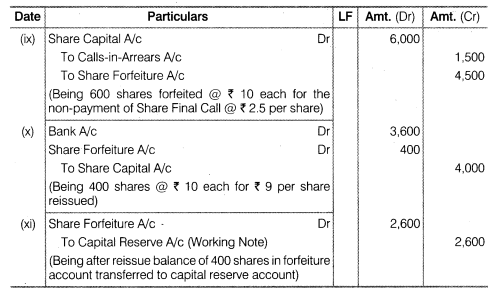
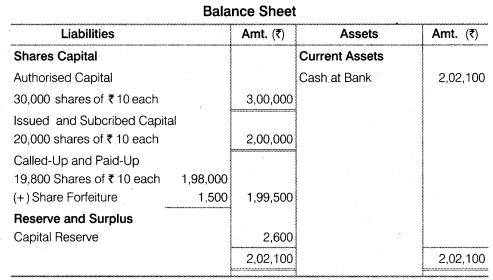

23. Journalise the following transaction in the books Bhushan Oil Ltd:
(a) 200 shares of Rs.100 each issued at a discount of Rs.10 were forfeited for the non payment of allotment money of Rs.50 per share. The first and final call of Rs.20 per share on these share were not made. The forfeited share were reissued at Rs.70 per share as fully paid-up.
(b) 150 shares of Rs.10 each issued at a premium of Rs.4 per share payable with allotment were forfeited for non-payment of allotment money of Rs.8 per share including premium. The first and final call of Rs.4 per share were not made. The forfeited share were reissued at Rs.15 per
share fully paid-up.
(c) 400 share of Rs.50 each issued at par were forfeited for non-payment of final call of Rs.10 per share. These share were reissued at Rs.45 per share fully paid-up.
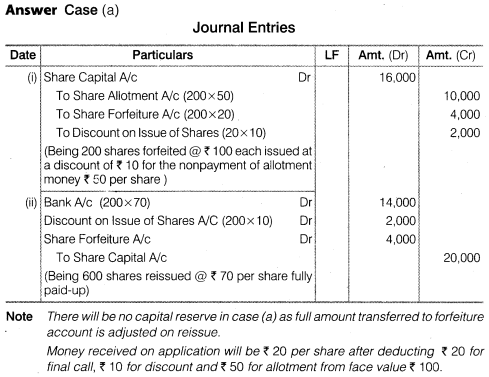
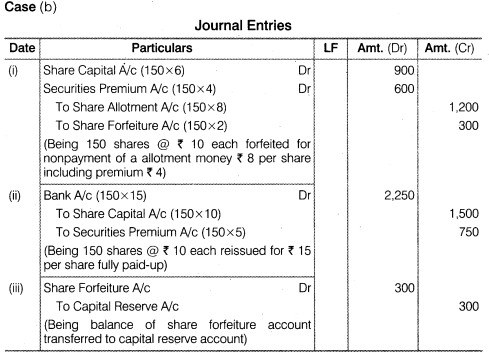
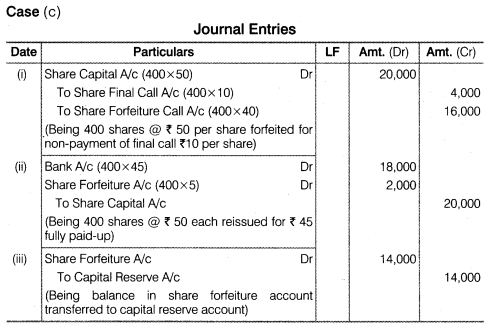

24. Amisha Ltd inviting application for 40,000 shares of Rs.100 each at a premium of Rs.20 per share payable; on application Rs.40 ; on allotment Rs.40 (Including premium): on first call Rs.25 and Second and final call Rs.15.
Application were received for 50,000 shares and allotment was made on prorata basis. Excess money on application was adjusted on sums due on allotment.
Rohit to whom 600 shares were allotted failed to pay the allotment money and his shares were forfeited after allotment. Ashmita, who applied for 1000 shares failed to pay the
Two calls and his shares were forfeited after the second call. Of the shares forfeited, 1200 shares were sold to Kapil for Rs.85 per share as fully paid, the whole of Rohit’s shares being included. Record necessary journal entries.
